Introduction
An electromagnet is a type of magnet powered by electricity. It is made up of a coil of wire wrapped around a core material, usually a ferromagnetic material such as iron or steel. When an electric current is passed through the coil, it generates a magnetic field, which can be used for a variety of purposes. In this article, we’ll explore the basics of electromagnets, how they work, and their practical applications in everyday life.

Exploring the Basics of Electromagnetism
Before diving into the specifics of how electromagnets work, let’s take a look at some basic concepts of electromagnetism. First, what is a magnetic field? A magnetic field is a force field generated by an electric current. The strength of the magnetic field is determined by the amount of current flowing through the conductor and the number of turns in the coil. The lines of force generated by the magnetic field are oriented in circles around the conductor.
The relationship between electricity and magnetism was first discovered by Michael Faraday in 1831. He found that when a conductor is placed in a changing magnetic field, a current is induced in the conductor. This phenomenon is known as Faraday’s law of induction. The reverse is also true: when a current is passed through a conductor, it generates a magnetic field. This is the principle behind electromagnets.

Investigating the Physics Behind Electromagnets
In addition to Faraday’s law of induction, there is another law that applies to electromagnets: Lenz’s law. This law states that the direction of the induced current will always oppose the change in the magnetic field that created it. This means that if you pass a current through a coil, the magnetic field produced by the current will oppose the original magnetic field. This opposition is what gives electromagnets their strong magnetic fields.
Another important concept to understand is magnetic flux density. Magnetic flux density (B) is a measure of the amount of magnetic flux passing through a given area. It is measured in Tesla (T). The higher the value of B, the stronger the magnetic field. For example, a 1 T electromagnet has a much stronger magnetic field than a 0.1 T electromagnet.
Examining the Components of an Electromagnet
Now that we have a better understanding of the physics behind electromagnets, let’s take a look at the components that make them up. The most important component is the core material. This is usually a ferromagnetic material such as iron or steel, which amplifies the magnetic field produced by the current. The core material is surrounded by a coil of wire, which carries the electric current. The number of turns in the coil and the amount of current passing through it determine the strength of the magnetic field.
Finally, the electric current is supplied by a power source. This can be either AC or DC, depending on the application. AC is typically used for applications that require a constantly varying magnetic field, while DC is used for those that require a more consistent field.

Practical Applications of Electromagnets in Everyday Life
Electromagnets have a wide range of practical applications in everyday life. One of the most common uses is in electronics manufacturing. Electromagnets are used to pick up and move electronic components during the assembly process. They are also used in medical devices such as MRI machines, pacemakers, and defibrillators.
In the automotive industry, electromagnets are used in fuel injectors, starters, and ignition systems. They are also used in industrial equipment such as cranes and hoists. Finally, they are used in consumer products such as speakers, motors, and generators.
Conclusion
In summary, electromagnets are powerful magnets powered by electricity. They are made up of a core material surrounded by a coil of wire, which carries the electric current. When an electric current is passed through the coil, it generates a magnetic field. This magnetic field can be used for a variety of practical applications in everyday life, from electronics manufacturing to medical devices.
By understanding the basics of electromagnetism, the components of an electromagnet, and their various practical applications, we can gain a better appreciation of how these powerful magnets work.
(Note: Is this article not meeting your expectations? Do you have knowledge or insights to share? Unlock new opportunities and expand your reach by joining our authors team. Click Registration to join us and share your expertise with our readers.)
